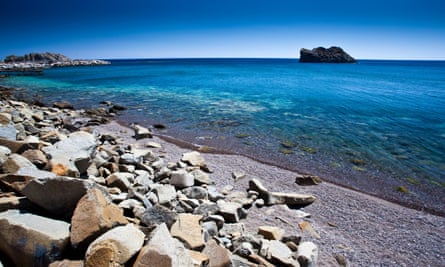
Greece
Seychelles, Ikaria
One of Lonely Planet’s best-value destinations for 2024, the Blue Zone island of Ikaria is renowned for the longevity of its inhabitants. On an island dotted with spectacular coves, Seychelles beach, 15 miles west of the capital, Agios Kirikos, is still a major lure. It’s a steep scramble to reach the sand, which is indicated by a roughly painted arrow in the middle of the road near the remote port of Magganitis (itself famed for a taverna where they serve seafood fresh from the boat).
Naming a Greek beach after an archipelago in the Indian Ocean could be considered hubris to match the flight of the island’s legendary Icarus, but with its white sand, pale pebbles and brilliant turquoise waters hemmed in by hunks of weathered rock, Ikaria’s version of the Seychelles doesn’t disappoint.
The perfect base for exploring the island, Erofili Beach hotel (doubles from €95 B&B) in the seaside resort of Armenistis has a small spa and a saltwater pool.
Skala Eressos, Lesbos
Lesbos’s southern coast is lined with breathtaking beaches, but Skala Eressos, a two-mile curve of dusky sand fringed by sea the colour of a jay’s wing, is definitely the best. Several hours’ drive from the island’s capital, Mytilene, via a mountain road that corkscrews through lunar landscapes dotted with bizarre rock formations, Eressos was the birthplace of the poet Sappho in the seventh century BC. The resort itself is a magnet for those seeking alternative lifestyles: vegan cafes and yoga and meditation centres line the pedestrianised seafront, alongside traditional tavernas with wobbly blue tables where they serve ouzo with just about everything. The beach is clean and rarely crowded, and there’s plenty of budget accommodation. Comfortable self-catering flats at Heliotropos (studio for two from €59 in June) are steps away from Skala Eressos beach.
Saria, Karpathos
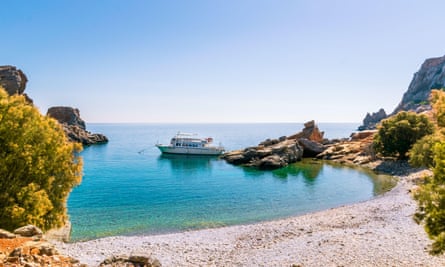
Karpathos is a four-hour ferry ride from Rhodes and a whopping 20-hour trip from Piraeus (the port of Athens), so it’s hardly surprising that this Dodecanese island has remained one of the country’s best-kept secrets. Topped by the mountain hamlet of Olympus, where women still dress in traditional costume, this rugged island is a favourite holiday destination for Greeks, who come here to laze on near-deserted beaches and eat the wild greens called tsimeta, kopelies (vegetable pies) and other specialities.
A real Robinson Crusoe experience is available a five-minute boat ride off Karpathos’s northern tip on the island of Saria. This deserted island is dotted with the barrel-roofed ruins of the homes of pirates who lived here in medieval times and its water is so clear that starfish can clearly be seen on the bottom. One of Karpathos’s newer boutique hotels, Afoti Beach (doubles from €65 B&B) has its own pool and restaurant near the main town, Pigadia, from where boats leave for Saria.
Xerokambos, Crete
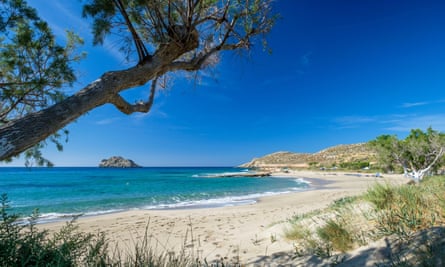
Home to one of Greece’s newest Unesco geoparks, the Sitia region on Crete’s remote eastern tip abounds in beautiful beaches, including Vai, the palm tree-studded beauty that starred in the 1980s Bounty adverts.
Reached via a narrow road that spins dizzily down through barren landscapes spiked with twisted thyme plants above a glittering sea, Xerocambos is definitely the most dramatic. Its coves are carpeted with golden sands and bathed by seas as blue as any in the Caribbean. Apart from half a dozen guesthouses and a handful of tavernas serving meze snacks, there aren’t many facilities; the only petrol stations are in Sitia, an hour’s drive away. There are no luxury hotels, but self-catering flats at Akti Rooms (sleeping two from €289 a week) are clean and comfortable.
Heidi Fuller-Love
Spain
El Rompido, Huelva, Andalucía
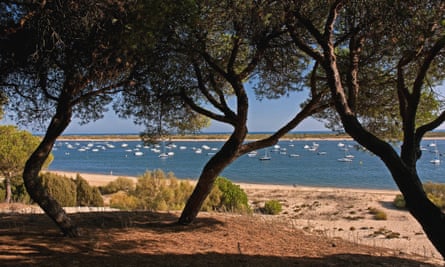
The eastern stretch of Huelva’s coast is wild and isolated, populated by a few campervans and people hang-gliding from the dunes. To the west, (towards the Portuguese border)the beaches are backed by condos, hotels and traditional fish restaurants, and packed with Spanish holidaymakers in summer. About half an hour west of Huelva city, El Rompido offers the best of both worlds: it’s a small, perfectly formed seaside resort with plenty of ice-cream kiosks, bars, boat trips, pine-shaded beach spots and affordable restaurants. As a bonus, La Flecha, an eight-mile spit of land parallel to the coast and accessible only by boat, offers spectacular virgin beaches of powder sand.
If El Rompido had a boutique hotel and a star chef, it would have topped Spain’s best beach lists year ago. It doesn’t, so thankfully it has remained charming, affordable and a little old-fashioned. Hotel Nuevo Portil (doubles from €74 room-only) is a modern four-star on the edge of town, minutes from the beach.
Playa de la Barrosa, Chiclana de la Frontera, Cádiz, Andalucía
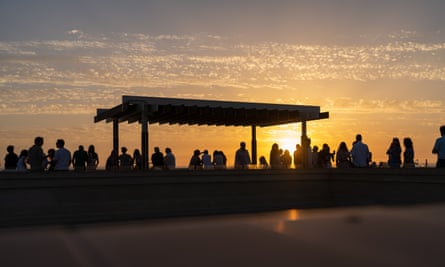
It’s a source of great wonder that La Barrosa isn’t better known outside Spain. True, the access road through the back end of Chiclana isn’t alluring, but the old town and seafront are pretty and the mighty beach in front of it – five miles of fine pale sand, 100 metres wide in parts, lapped by gentle waves – frequently features on Spain’s own best beach lists. While by no means a new destination, it now has added allure thanks to the recent addition of beach clubs, modern restaurants from cheap (El Arbol Tapas) to Michelin-starred (Alevante) along with venues such as El Cuartel del Mar combining wellbeing, fine-dining and art space in a former military base.
There’s no stopping the poshing up of La Barrosa, but for now it remains a top beach and not fundamentally changed. There are still family-run hotels right on the beach, such as El Campanario (doubles from €130 room-only). And even on the busiest days there are still quiet spaces among the dunes beyond Torre del Puerco.
Sorrel Downer
Oleiros, Galicia
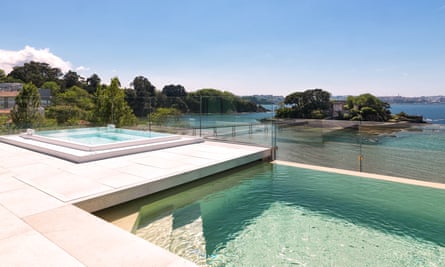
Spain has finally remembered the city of A Coruña, over there on its north-westerly tip, and visitors are staying on to explore its maritime hinterland. While the city has plenty of seafront, the best beaches, inlets and tiny coves lie east across the estuary around the town of Oleiros. This is where locals escape for laid-back, bucket-and-spade summer fun.
Santa Cristina beach in the mouth of the Mero river is the longest and closest; further north, As Margaridas, tiny with turquoise water, is among the most exquisite. The 2019 opening of Noa Boutique Hotel (cool, glass-fronted and virtually on the water) consolidated Oleiros’s position as a stylish beach destination (doubles a steal at €85 B&B in winter, €183 in summer). The town’s foodie fame adds to its allure: for classic gallego seafood there’s El Refugio, long popular with millionaires, fishers and politicos, while La Panaderia By Sarah seats just 20 in a converted bakery.
Calblanque, Murcia
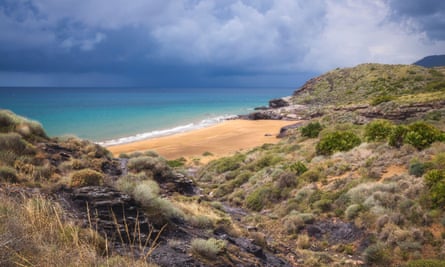
For decades, tourists have flocked to Murcia to enjoy the resorts along the Costa Cálida and Mar Menor lagoon. Now the buzz in Murcia is around destinations with nothing: no Irish pubs, no nightclubs – not even car access or mobile phone coverage. Hottest, in every respect, are the coves and coastal trails of the arid, rocky Calblanque regional park, south of the main road leading east from Cartagena. The best and wildest beaches are in the south-west, after the dirt road peters out close to Playa Larga.
Hiking through silence, cypress and pine, with spectacular views of the sea is part of the escape-from-the-modern-world experience. And for those who need to sustain the vibe, there’s now a scattering of simple but ultra-stylish, white-walled, outside-is-the-new-inside, wooden-beamed holiday lets. Lovely Las Moonas en Calblanque (sleeps two from €120, minimum two nights) is a 15-minute walk from the most westerly of the western beaches, Punta Parreño.
France
Plage des Sabias, Île d’Yeu
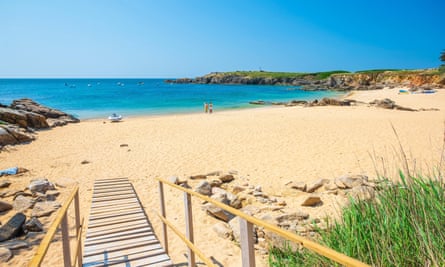
While crowds descend on the Île de Ré, those in the know head for one of France’s lesser-known western islands, the Île d’Yeu. Only six miles long and 2½ wide, it is reached by passenger ferry from Saint-Gilles Croix de Vie or Fromentine on the Vendée coast. Its beaches are quiet coves of golden sand, and none is more idyllic than Plage des Sabias, which is backed by shabby-chic whitewashed fishers’ cabins, with blue shutters and doors.
The beach is ideal for kayaking or paddleboarding, and is a short stroll from Le Vieux Chateau, a partly ruined fort that dates from the 14th century. The island is perfect for exploring by bikes, which can be hired in the main town of Port-Joinville. The idyllic town of Saint-Sauveur, with its whitewashed cottages and primary-coloured shutters, will welcome a new hotel-restaurant from April 2024. La Mission will have 22 rooms and suites, and a pool, spa, bar and restaurant (doubles from €290 room-only in June and €150 off season). For a cheaper billet, the Atlantic Hotel in Port-Joinville has doubles from €95 room-only.
Plage du Penon, Landes
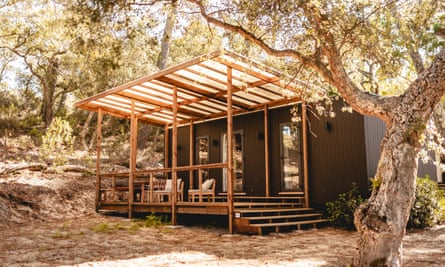
With wide stretches of golden sand and rolling waves, the southern stretches of the Atlantic coast are perfect for active beach lovers, particularly those wanting to surf or body-board. At Plage du Penon and Plage des Casernes surfers can brush up their skills at one of several surf schools, such as Enjoy École de Surf (1½ hours from €40) or École Surf Côte Française (1½ hours is €45).
A mile inland at Seignosse, Les Maritimes is a revamped camping village on a site previously called Camping Les Chevreuils. Its accommodation options range from smart beach houses with Nordic hot tubs to more traditional mobile homes. There are also camping pitches beneath the towering pines. There is a restaurant and bar, which offers evening entertainment, as well as a pool and spa, with massages and yoga available. Beach houses sleeping four start at €760 a week in June.
Plage de Ciboure, Basque Country
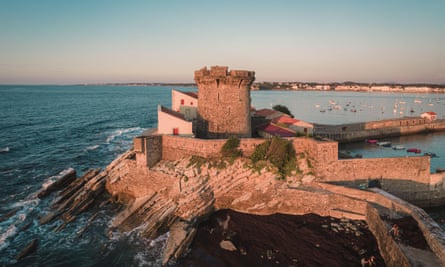
On the other side of the bay from Saint-Jean-de-Luz’s crescent of golden sand at La Grande Plage is the equally alluring but smaller Plage de Ciboure. The bay is sheltered from mighty Atlantic waves by two coastal barrages, which makes both beaches good for small children.
Bigger kids in search of an adrenaline high might try the Jet Surf experience, a motor-powered surf-board that users can stand, kneel or lie on as it zips back and forth (€60 for 25 minutes). The experience can be booked at Socoa, where a long breakwater juts out from the 17th-century fort – a 10-minute walk away. For a more sedate experience there is wine tasting at Egiategia, a sustainable winery that overlooks the beach.
The wines are matured in containers under the sea to make the most of the cooler temperatures, with a much lower carbon footprint than artificially cooled cellars. A visit with tasting costs from €10 (45 minutes). La Reserve in Saint-Jean-de-Luz has doubles from €192 room-only; Hotel La Caravelle on the Ciboure side of the Nivelle River has doubles from €159 room-only.
Plage de la Figueirette, Côte d’Azur
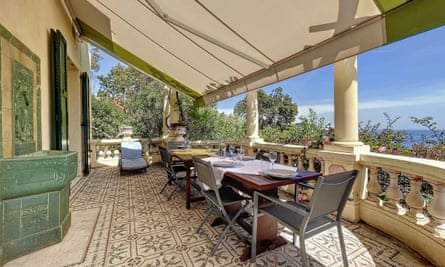
Near Théoule-sur-Mer, south-west of Cannes and near the border with the quieter Var department, Plage de la Figueirette is a 300-metre stretch of white sand near a small harbour. There are good facilities, such as toilets and nearby parking, as well as two restaurants. It makes a good spot for a cooling swim after a hike among the rugged red rocks of the Esterel Massif.
It is also a good pit stop for those driving or cycling the spectacular coastal route called La Corniche d’Or, from Saint-Raphael to Cannes. The route loops between red rocks dotted with green shrubs, overlooking the blue Mediterranean. Villa Les Camélias is a beautiful belle époque Villa at Le Trayas, up a winding road less than a mile from the beach.
It’s a new addition to the Sawday’s collection, sleeps 10 (six adults and four children) and has spectacular sea views, from €537 a night in June.
Carolyn Boyd
Croatia
Sveta Katarina, Istria
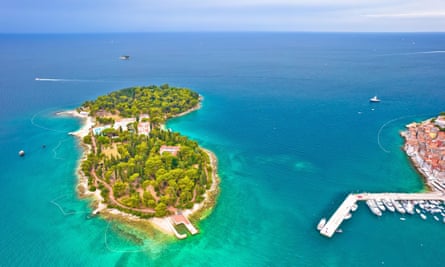
Salsa fans descend on Rovinj every June for the Croatia Summer Salsa festival, which in 2024 celebrates 20 years of filling the harbour with open-air stages and dancing. But about 10 minutes away by shuttle boat is the tiny island of Sveta Katarina, so close yet a world away. There’s no permanent settlement and only one hotel, the three-star Maistra Select Island Hotel Katarina (doubles from €141 room-only), behind which is a pebbly beach with sunbeds, a few cafes and a relaxed, family-friendly vibe.
A path through the woods leads to more secluded stretches of rocky coast, with sunbeds beneath the pines. It feels like an island hideaway far from the crowds, but without the high price tag. And the views of Rovinj from here are superb.
Šimuni, Pag
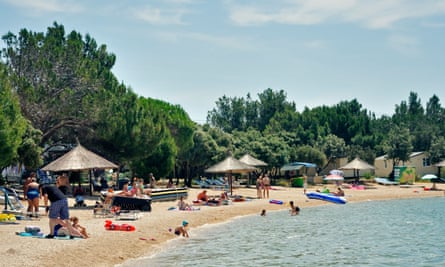
Pag’s hedonistic beach nightclubs and all-night dance festivals seem to get bigger every year, and there’s no let-up in 2024. But those not into the nonstop parties of Novalja and Zrće Beach can escape to the west of this island of olive groves and grazing sheep to the village of Šimuni, with its pebbly beaches backed by pine and oak forest.
The village and marina surround a deep harbour, but the beaches to the north and south offer stupendous sunsets and just enough beach bars for a gentle buzz. It’s a favourite camping spot – mobile homes at Camping Village Šimuni are right on the beach and cost from €125. Šimuni is about eight miles from attractive Pag town, which often gets overlooked in favour of the party hotspots and is worth a visit.
Južna Luka, Ugljan
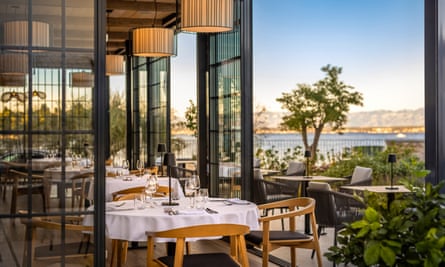
A 20-minute ferry ride from Zadar is the island of Ugljan, which hides in plain sight of tourists wandering along Zadar’s waterfront. Here chef and hotelier Stjepan Dunatov recently brought life back to his ancestral home by turning the 1912 townhouse into a 14-room boutique hotel in the ferry port of Preko (Dunatovi Dvori Heritage hotel has doubles from €117 room-only).
At the northern end of this pretty, laid-back island is secluded Južna Luka, which has a cooling backdrop of pine trees round the U-shaped bay. Beyond the large boulders along the shore are vivid blue-green waters that cry out to be explored with a snorkel. A footpath circles a round peninsula west of the beach, and is magical at sunset. There are superb views from the top of Liburni hill, a 20-minute walk away.
Brbinjšćica Bay, Dugi Otok, Zadar
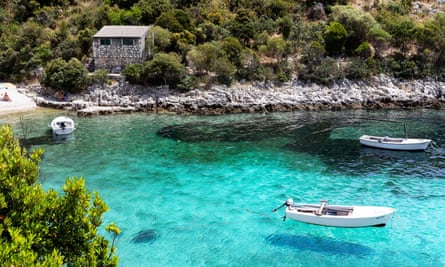
With each year, Dugi Otok’s popular Sakarun beach gets busier. But the beach at Brbinjšćica Bay remains quieter, thanks to the very narrow track that eventually leads to this sheltered pebbly cove surrounded by limestone hills. Here there’s nothing to do but swim, chill out and picnic. Kayaks can be rented from the beach’s little shack for exploring two wondrous sea caves, Dragon’s Eye and Gobulinka, just outside the bay. The gorgeous turquoise waters are also perfect for paddleboarding.
Dugi Otok (which, at 28 miles long, suits its name of “long island”) is part of the Zadar archipelago and easily reached by ferry from the city. About 20 minutes from Brbinjšćica Bay, Luka makes a good base, and Picić Guesthouse has doubles with sea views and balconies from €110 room-only.
Mary NovakovichAuthor of My Family and Other Enemies: Life and Travels in Croatia’s Hinterland
Italy
Gallipoli, Puglia
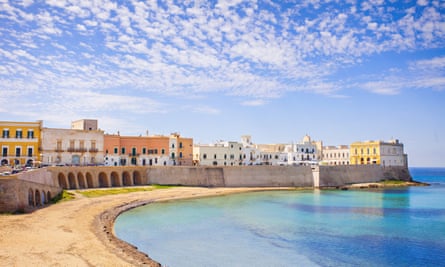
Puglia’s best beaches are on its Ionian coast: one idyllic stretch is even called the “Maldives”. North of there, the walled town of Gallipoli is less famous than its Turkish namesake but just as beautiful, with a sandy “free” beach in its island old town.
Getting there is simpler now: new Frecciarossa trains from Milan arrive at the baroque town of Lecce, 26 miles from Gallipoli, in under nine hours. Sleepers leaving Milan at 9.15pm take longer, but reach Lecce at a civilised 10.02am. There are onward trains from Lecce, but it’s fun – and not too taxing in this flat, rural region – to make for the coast by bike (rent from Salento Bici, minutes from Lecce station), perhaps stopping for a lunch of open friselle sandwiches in pretty Nardò.
Those without wheels might prefer a B&B in Gallipoli, such as Punta Cutieri (€107 B&B) with its sea-view terrace, but a 15-minute bike ride out of town is Tenuta Ferraro (€76 B&B), an agriturismo with spacious rooms, a large pool and home-cooked dinners. Punta della Suina, an area of wild sandy coves, is a half-hour pedal away.
Sperlonga, Lazio
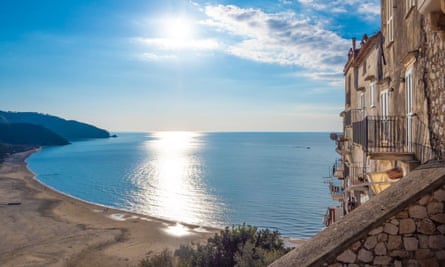
Canny Romans like to keep this jewel of a whitewashed town, on its promontory between sandy beaches, to themselves. Italian resorts rarely escape the march of the beach concession, but Sperlonga has five miles of sand, and several “free” stretches, particularly south of 16th-century Torre Truglia.
Romans have long sought peace and beauty in Sperlonga: Emperor Tiberius had a villa here until AD26, when a rock fall in his grotto dining room sent him scurrying to Capri. The villa ruins can be seen from the beach, but the ancient sculptures in its museum (€7, entered off the coast road, Via Flacca) brought home to me what “Renaissance” really means. There’s spectacular but not-too-difficult rock climbing at the Avancorpo di Sinistra cliff south of the town.
Fondi-Sperlonga station is a few miles inland on the Rome-Naples line, and shuttle buses run to Sperlonga seafront. B&B Sperlonga (doubles €125 B&B) is run by friendly Pina and Enrico on a tree-lined street minutes from the beach. All rooms have balconies, and there’s a terrace for breakfast and bikes to hire.
Trapani, Sicily
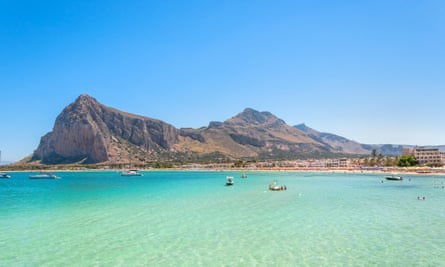
Taormina was famous before White Lotus, but Sicily’s wilder west has stayed under most foreigners’ radar. Trapani is one of Italy’s oldest cities, dating back 3,000 years, and Greek, Carthaginian, Byzantine, Arab, Norman and Spanish invaders left their mark on its old town. The name comes from Greek drepanon, meaning sickle, which perfectly describes its 2½ miles of sand, with gin-clear water. Piazza Vittorio Emanuele beach is central, sandy and free, as is Spiaggia Tipa, further east, and there’s a cable car to hilltop Erice. Trapani is linked by (slow) train to Palermo, 60-odd miles away, but those who come by hire car can also explore the beaches of San Vito lo Capo, Mozia’s ancient saltworks and Marsala.
Look out for trapanese pesto, made with almonds, garlic and cherry tomatoes. And if 2023’s heatwave put you off Sicily, think outside summer: Trapani winters can hit the high teens. Residence La Gancia has sea-view studios with kitchen and balcony (€124, including generous breakfast on a top-floor terrace).
Scilla, Calabria
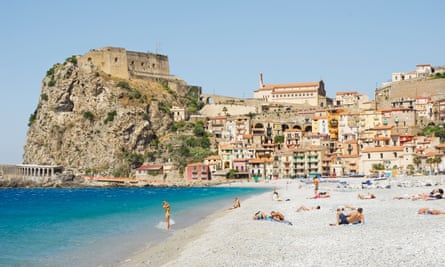
Some might remember from school how six-headed serpent Scylla scared sailors into the whirlpool of Charybdis across the Messina Strait. But today’s Scilla is anything but monstrous: the train arrives in Marina Grande, by a silvery beach whose water Italians often rate among the country’s best: clear, warm and multihued. The old town is on a plateau above, with stunning views. The harbour, lighthouse and Castello Ruffo (open to the public) sit on a narrow promontory, and to its east is the old fishing quarter of Chianalea, with its beach, Oliveto.
The joy of this area, the Costa Viola, is the railway that hugs most of the coast, and can be used for hikes on panoramic trails (see wikiloc.com). I know of SUPers who paddle out from Scilla then pack their inflatable boards and jump on a train back to town. The local speciality is swordfish (pesce spada), which makes a brilliant panino with mild pink onions from nearby Tropea. Again, this is a place for warm days in early summer or autumn, not sweltering August. On a narrow street under the castle, Il Porticciolo is a four-room B&B (from €72) with sea views and breakfasts on a cute balcony.
Liz Boulter
Portugal
Praia dos Coxos, near Lisbon
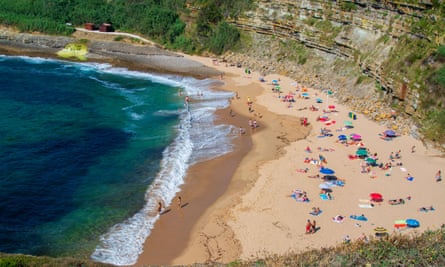
A small bay protected by cliffs, Coxos is a good swimming spot when the waves are not too big. Lagoons form around the rocks at low tide, so children can splash and play safely. The beach, which has a cute cafe in high season, is four miles north of Ericeira – a whitewashed former fishing town that is now one of Portugal’s top surf spots – and walking distance from Ribamar, with its excellent marisqueiras (seafood restaurants).
Nearby, atop a 40-metre cliff overlooking the Atlantic, is Aethos, a swish modernist hotel (doubles from €224.50 or four-bunk “surfers” rooms from €258). It has a heated saltwater pool and a wellness centre with meditation, yoga and hammam. Complimentary ebikes allow guests to explore the trails leading to beaches including Coxos, and Praia da Calada, which also has wheelchair access. The hotel provides surf coaching and a “surf concierge” to advise on the best spots and times.
Parque natural da Arrábida, near Lisbon
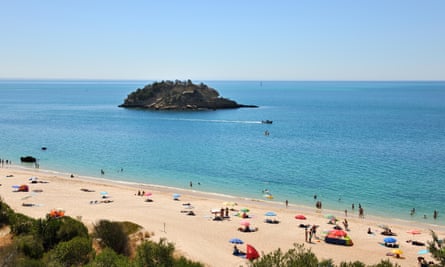
This natural park between the fishing towns of Setúbal and Sesimbra is a 40-minute drive from Lisbon yet still largely undiscovered by tourists. The Serra de Arrábida mountains run down to a coast peppered with beaches such as Praia do Creiro, Praia dos Coelhos and stunning Praia dos Galapinhos. Horse riding along the shore, hiking in conservation areas, and winery visits are big draws in the park, along with the fine sands and Atlantic roar.
West of the park, Villa Epicurea (doubles from €225 including vegetarian breakfast) is a wellbeing focused, eco-friendly destination with suites and “tiny houses” with views over the Serra de Arrábida forest to the ocean. It also has a geodome for yoga sessions and a natural swimming pool, and is 15 minutes by bike from Praia do Inferno, a small beach which, in spite of its name, is completely calm.
Praia da Aguda, near Porto
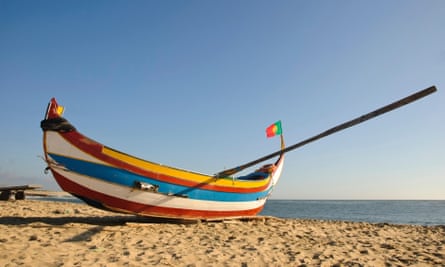
Aguda is one of a series of beaches strung like gems along the Costa Verde south of Porto. Golden sand, a harbour and a protective sea wall give a more sheltered feel than some nearby beaches, and the village has lovely old fishers’ houses.
A seven-mile wooden boardwalk takes in the fishing town of Espinho, which has fantastic seafood restaurants and – in November – a film animation festival, Cinanima. Brightly painted fishing boats land their catch directly on the Espinho beach using a method called xávega, where a fine net is pulled to shore by tractor.
Casa da Granja (doubles from €154 B&B) is a converted mansion two streets from the beach with five guest rooms. It has a pool, garden and library and is a 15-minute walk from Granja station, for trains to Porto Campanhã in less than half an hour.
Praia da Ponta da Areia, Algarve
Ponta da Areia is Portugal’s most easterly beach, a largely untouched place of tranquillity, very different from the high rises of Monte Gordo a couple of miles away. Between the two, Caramelo Beach Club sells drinks, grilled fish and snacks.
Praia da Ponta da Areia is on the Guadiana river, which forms the border with Spain. On its banks sits 818 Centro Náutico (bungalow for two from €130), with timber lodges, an infinity pool, a restaurant and a tiny beach. The main beach is a short cycle or 25-minute walk away through pine trees and dunes. Hire bikes can be arranged, and 818’s watersports facility, Nautitours, offers boat trips, canoeing and jetskiing.
The border town of Vila Real de Santo António is a short stroll from the door, and 15 minutes by ferry from the Spanish town of Ayamonte, where they have tapas instead of Portuguese petiscos. It’s also in a different time zone, so returning passengers feel they have gained an hour.
Audrey Gillan



